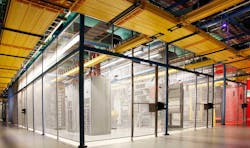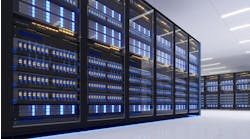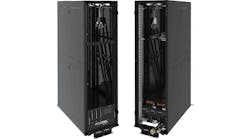As it seeks to conserve energy and water, Equinix will raise the temperature in its data centers, creating a warmer environment for customer IT equipment. Equinix says it expects to operate its data halls at 80 degrees, warmer than the traditional range of 68 to 72 degrees in enterprise facilities, a move that could help thousands of Equinix customers reduce carbon emissions in their supply chain.
Equinix becomes the first colocation provider to make a public commitment to run warmer data centers, which means less use of electricity and water used to keep servers and storage equipment cool. The decision reflects a growing focus on sustainability, as well as years of data from hyperscale providers showing that IT equipment can run at higher temperatures with minimal impact on reliability.
The changes will occur gradually as Equinix defines a "multi-year global roadmap for thermal operations," providing time for the company to verify its expectations and customers to prepare for the change. Equinix expects to operate its facilities closer to 27°C (80°F), consistent with the A1A standards for IT equipment defined by ASHRAE (American Society of Heating, Refrigerating and Air-Conditioning Engineers).
A Sustainability Strategy Expands Beyond Hyperscale
Warmer temperatures are difficult in multi-tenant colocation facilities like those operated by Equinix, which feature data halls shared by multiple customers, not all of whom are likely to have experience operating equipment in hotter environments.
“Equinix will work with enterprises to change the way we think about operating temperatures within data center environments," said Rob Brothers, Program Vice President, Datacenter Services, IDC. "With this initiative, Equinix will play a key role in driving change in the industry and help shape the overall sustainability story we all need to participate in.”
The energy savings could be significant, according to Raouf Abdel, Executive Vice President, Global Operations for Equinix.
“Our cooling systems account for approximately 25% of our total energy usage globally,” said Abdel. “With this new initiative, we can intelligently adjust the thermostat in our data centers in the same way that consumers do in their homes. Once rolled out across our current global data center footprint, we anticipate energy efficiency improvements of as much as 10% in various locations.”
It also means Equinix is reducing its carbon impact, which is a growing concern for customers who are seeking to address climate change by reducing the emissions from their supply chain, known as Scope 3 emissions.
“As more than 10,000 businesses globally rely on Equinix’s digital infrastructure, it plays a critical role in their supply chains," said Jon Lin, Executive Vice President and General Manager, Data Center Services for Equinix. "This initiative, once deployed, has the potential to significantly benefit these businesses as they seek to reduce the Scope 3 carbon emissions in their supply chain to meet their overall climate targets. It marks an important step in our comprehensive sustainability program and our climate-neutral commitment.”
Moving Beyond the 'Meat Locker' Data Hall
Warmer data centers have been a hot topic for many years. In the early days of the IT industry, data centers often resembled meat lockers due to the belief that cooler temperatures extended the life of servers and storage units. Through the mid-2000s, most data centers operated in a range of 68 to 72 degrees F.
As data centers grew larger and more sophisticated, the industry began to test common assumptions about operating temperatures. In 2009 Google said it had boosted its the set point in its data halls to 80 degrees, saying the move had little impact on server failure rates. Hyperscale operators have continued to fine tune their cooling to boost their energy efficiency This year Meta said it has begun operating its data halls at 90 degrees, while Microsoft also says it plans to operate its data centers at warmer temperatures.
The Equinix announcement is notable because the company is the largest provider of colocation and interconnection services, with 10,000 customers and 229 data centers across the globe.
"We are currently evaluating our data center portfolio to define a change-management roadmap that will eventually span our entire global portfolio," the company said. "The new environmental standard will then be gradually adopted across our IBX portfolio. Equinix will work to ensure all clients receive ample notification of the planned change to their specific deployment site."
Operating at higher temperatures brings several considerations:
- In the event of a cooling failure, a warmer facility has less time to recover before data hall temperatures rise to worrisome levels, requiring users to power down equipment.
- There are historic concerns that warmer environments can lead to more failures and shorter useful life for equipment. Hyperscale users now have extensive data on failure rates at various temperature ranges and are comfortable operating well above 80 degrees.
"There is no immediate impact to our general client base, as we expect this change to take place over a multi-year horizon and we will work directly with clients to address any concerns," the company said. "Equinix operates several IBX locations that currently operate at 25C (77 degrees F) without issue. It is encouraging to note that the A1A standard was published with the consultation of equipment manufacturers who have been designing equipment in line with the standard for many years."
The refinements are part of a broader effort at Equinix to make its cooling systems more efficient and sustainable. Equinix has been testing the use of liquid cooling in its data centers, and hopes to use the technology in its Equinix Metal service to create a high-density, energy efficient computing platform. The company is also testing liquid-cooled NVIDIA GPUs in the Equinix Co-Innovation Facility (CIF) in Ashburn, Virginia, where the huge digital infrastructure company is test-driving technologies that will drive the data center of the future.
Wider temperature ranges could enable additional design innovation, the company said.
"We expect to continue to assess how changes to future design could be optimized as we make this transformational change," Equinix said in an email to DCF. "We anticipate that changes to both the electrical and mechanical infrastructure may be possible in future in support of the goals of improving our energy efficiency and reducing our overall energy consumption."






